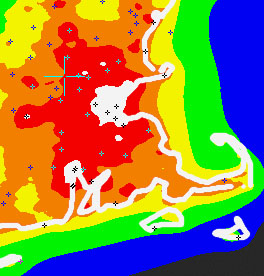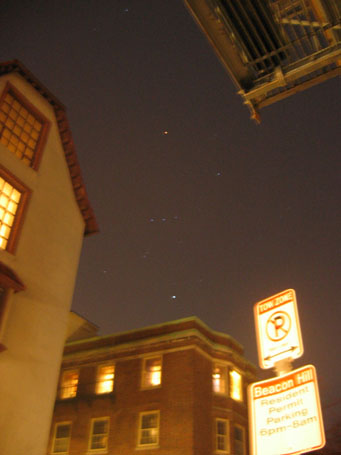I became obsessed with measuring skyglow when I first started participating in the Internet newsgroup sci.astro.amateur. In responding to questions about why people couldn't see galaxies through their telescopes, it soon became obvious that light pollution was the main culprit. But how could I judge how bad somebody else's light pollution was without actually being there? It seemed almost as hopeless as feeling another person's toothache.
The traditional measure of skyglow is naked-eye limiting magnitude, or NELM — the faintest star that you can see with the unaided eye. But people would report NELMs far worse than anything I'd ever experienced -- so bad that they almost couldn't be right. Or they would be so vague that they conveyed no information, like "my NELM is 2 or 3." That's like saying "Do you think I'm too fat? My weight is somewhere between 200 and 500 pounds." It's common to have trouble seeing a 3.9-magnitude star from a city center, but 2.0-magnitude stars begin to be visible 30 minutes after sunset, when the sky is still bright blue. It's almost impossible to imagine artificial skyglow that would blot out such bright stars on any half-decent night. (Direct glare from overhead lights is another matter — that can blind you to almost anything.)

The big cross marks the site of my astronomy club's observing site.
Clear Sky Clock
I eventually found three semi-objective ways to convey skyglow. The simplest is to look at the World Light Pollution Atlas and report the color that it assigns to your light-pollution zone. The Clear Sky Chart provides a fairly straightforward interface to find out where you are in the Atlas. The Atlas is far from perfect, but even so, if you say that you live in the orange zone, that conveys a lot more to me than if you report that your NELM is 4.5.
The second way — the best currently available — is to purchase a Sky Quality Meter (SQM) that reads out in magnitudes per square arcseconds, the measure of surface brightness most often used by professional astronomers. A brightness of magnitude 22 per square arcsecond (22 mpss) is what you'd get if you spread the light of a 22-magnitude star over one square arcsecond of sky. That's more or less the darkest possible reading — the light that comes only from natural sources like the Milky Way, the zodiacal light, and airglow. The SQM is wonderful because it provides a very precise measurement that's uniform across all observers. If you tell me your SQM reading is 19.5, I know exactly what your skies are like.

This photograph indicates that the skyglow near Orion's belt, as seen from Boston's posh Beacon Hill, was magnitude 16.5 per square arcsecond.
Tony Flanders
Finally, I've perfected the art of using digital cameras to measure skyglow for my own purposes (S&T February 2006, page 99). Unlike the SQM, this does not require an unobstructed view of the sky, and it can be used when there are street lights not far away. But I haven't figured out a good way to calibrate different models of cameras so that everybody gets comparable readings.
Although I'm skeptical about the scientific value of star counts, or NELM surveys, we've been promoting them in the magazine, and I'm certainly willing to give them a fair shakedown. So I spent the last two nights traveling from the center of Boston to a little outside the inner belt highway measuring skyglow with SQM, camera, and NELM. My results are shown below. The NELMs are very crude; I was gathering data for the Globe at Night project, which only asks you to estimate NELM to the nearest magnitude.
All of the SQM readings are considerably lower (that is, brighter) than they would normally be at this time of year because we have fairly solid snow cover, which reflects light back into the sky. Two months from now, when the snow is gone and the leaves have come out, the readings will be about one half magnitude higher (darker). And because Orion was fairly low in the sky, the skyglows in that constellation were actually about one half magnitude lower (brighter) than the ones shown here, which were all measured at the zenith.
To put these numbers into familiar context, when the SQM reads 18.0, I can just see the Andromeda Galaxy without optical aid when it's at its highest, but I can't see the Milky Way at all. When the SQM reads 19.0, the brightest parts of the Milky Way are readily visible when they're overhead, though severely washed out.
| Site |
Miles from downtown |
SQM (zenith) |
NELM in Orion |
| Boston Common | 0.0 | 16.6 | 3.8 |
| Cambdridge Common | 3.9 | 17.3 | 4.1 |
| Danehy Park (NW Cambridge) | 5.0 | 17.4 | 4.1 |
| Arlington, MA | 6.6 | 17.9 | 4.4 |
| Lincoln, MA | 13.0 | 18.6 | 4.9 |
 2
2
Comments
Dave
July 30, 2007 at 1:36 pm
Nice article - just saw it now! Anyways, I just got an SQM and my first reading (last night at 10:45PM with almost full moon was 18.51. This is for the west side of Bolton, MA (about 5-6 miles into the "orange" zone...
I had previously estimate (and I'm a total noob at this) my NELM to be around 5.5ish (on non full moon nights that is)...
We shall see how things progress... Are you aware of any other Boston areas capturing a database of SQM readings?
Clear (and dark!) skies to you
Dave
-----
Tony responds: I have a copious database of SQM readings, as I take them routinely for almost every observing session. I know several other people around Boston who own SQM's, but I don't know if they use them regularly.
When taking a reading with the Moon up, you have to be careful to shade the SQM from direct moonlight; otherwise it will perturb the reading. 18.5 sounds about right for a nearly full Moon; see my entry "How Brightly Shines the Moon?"
You must be logged in to post a comment.
Boba
August 5, 2008 at 4:26 pm
I am doing a project in a Petnica Science Center in Serbia and my assignment is to create a model of skyglow of the research center yard(area of a few thousands of square meters) with outdoor lights turned on and another one with the lights turned off. I tried to do it with SQM, but as You said it is not a good solution with the light that is too near (because of its wide angle sensor), so I need to know which is the best way to do this task. I suppose that digital camera is one of the solutions, but I would appreciate a lot if you could give more information on how to do it precisely. My e-mail is [email protected]
I hope I will hear a word from you.
Thank You in advance
You must be logged in to post a comment.
You must be logged in to post a comment.